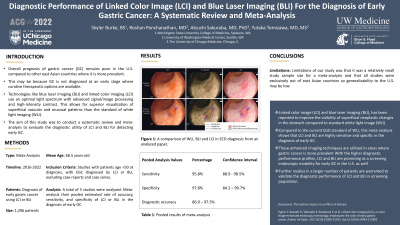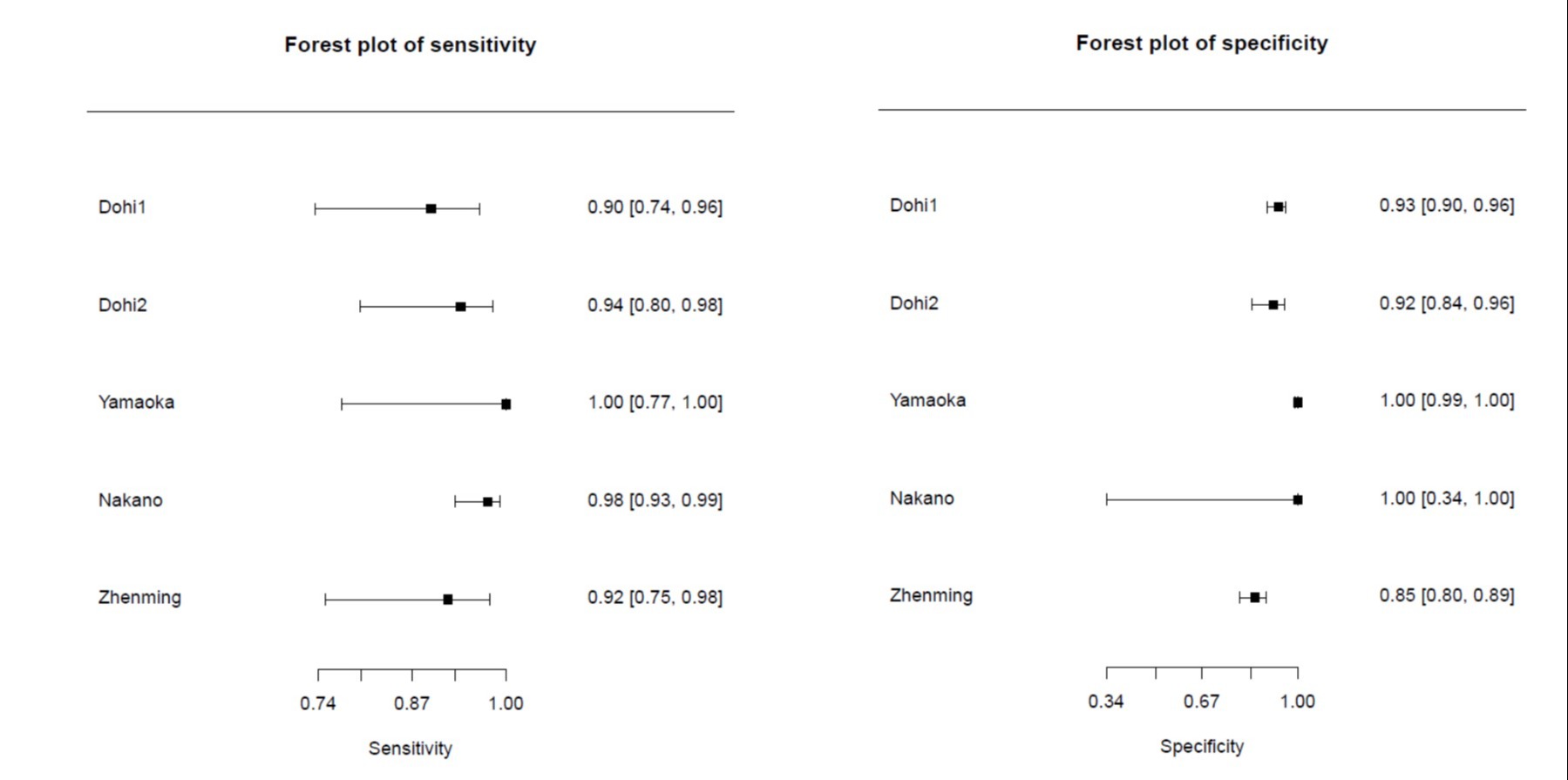Back


Poster Session D - Tuesday Morning
Category: Stomach
D0692 - Diagnostic Performance of Linked Color Image (LCI) and Blue Laser Imaging (BLI) for the Diagnosis of Early Gastric Cancer: A Systematic Review and Meta-Analysis
Tuesday, October 25, 2022
10:00 AM – 12:00 PM ET
Location: Crown Ballroom

Has Audio

Skyler Burke, MS
Washington State University
Seattle, WA
Presenting Author(s)
Skyler Burke, MS1, Roshan Panchanathan, MD2, Atsushi Sakuraba, MD, PhD3, Yutaka Tomizawa, MD, MSc2
1Washington State University, Seattle, WA; 2University of Washington, Seattle, WA; 3University of Chicago, Chicago, IL
Introduction: Overall prognosis of gastric cancer (GC) remains poor in the United States, and this may be because GCs are not diagnosed at an early stage where curative therapeutic options are available. Esophagogastroduodenoscopy (EGD) is the gold standard diagnostic tool; however, it is often difficult to detect early GC even with high definition while light (HDWL) imaging because of its subtle mucosal changes seen on early neoplastic changes in the stomach. Using a combination of an optimal light spectrum with advanced signal/image processing and high-intensity contrast imaging allows for superior visualization of superficial vascular and mucosal patterns than HDWL imaging. Such newer generation image-enhanced endoscopy systems with linked color image (LCI) and blue laser imaging (BLI) has been reported to improve the visibility of superficial neoplastic changes in the stomach. We aimed to conduct a systematic review and meta-analysis to evaluate the diagnostic utility of LCI and BLI for detecting early GC.
Methods: Electronic literature search was conducted from inception through May 2022 for articles reporting the diagnostic yield of LCI or BLI for the diagnosis of early GC. The primary outcome of interest was sensitivity and specificity, and we calculated the proportion of patients who met the outcomes of interest in each study. In the meta-analysis, outcomes were documented by weighted pooled rates with 95% confidence intervals (CI) and corresponding forest plots were constructed. They were analyzed using a random-effect model.
Results: Five studies reporting the outcomes on a total of 1296 patients (mean age 68.5 years) were included in the final analysis. Pooled estimated rate of sensitivity and specificity of LCI or BLI in the diagnosis of early GC were 95.8 % (95% CI 88.9-98.5) and 97.8% (95% CI 84.2-99.7%), respectively. The diagnostic accuracy was also favorably high (range 86.0-97.5%).
Discussion: The results of our meta-analysis demonstrated that LCI and BLI are highly sensitive and specific in the diagnosis of early GC. With higher diagnostic performance profiles, LCI and BLI are promising as a screening endoscopic modality for early GC. Further studies in a larger number of patients are warranted to validate the diagnostic performance of LCI and BLI in screening population.

Disclosures:
Skyler Burke, MS1, Roshan Panchanathan, MD2, Atsushi Sakuraba, MD, PhD3, Yutaka Tomizawa, MD, MSc2. D0692 - Diagnostic Performance of Linked Color Image (LCI) and Blue Laser Imaging (BLI) for the Diagnosis of Early Gastric Cancer: A Systematic Review and Meta-Analysis, ACG 2022 Annual Scientific Meeting Abstracts. Charlotte, NC: American College of Gastroenterology.
1Washington State University, Seattle, WA; 2University of Washington, Seattle, WA; 3University of Chicago, Chicago, IL
Introduction: Overall prognosis of gastric cancer (GC) remains poor in the United States, and this may be because GCs are not diagnosed at an early stage where curative therapeutic options are available. Esophagogastroduodenoscopy (EGD) is the gold standard diagnostic tool; however, it is often difficult to detect early GC even with high definition while light (HDWL) imaging because of its subtle mucosal changes seen on early neoplastic changes in the stomach. Using a combination of an optimal light spectrum with advanced signal/image processing and high-intensity contrast imaging allows for superior visualization of superficial vascular and mucosal patterns than HDWL imaging. Such newer generation image-enhanced endoscopy systems with linked color image (LCI) and blue laser imaging (BLI) has been reported to improve the visibility of superficial neoplastic changes in the stomach. We aimed to conduct a systematic review and meta-analysis to evaluate the diagnostic utility of LCI and BLI for detecting early GC.
Methods: Electronic literature search was conducted from inception through May 2022 for articles reporting the diagnostic yield of LCI or BLI for the diagnosis of early GC. The primary outcome of interest was sensitivity and specificity, and we calculated the proportion of patients who met the outcomes of interest in each study. In the meta-analysis, outcomes were documented by weighted pooled rates with 95% confidence intervals (CI) and corresponding forest plots were constructed. They were analyzed using a random-effect model.
Results: Five studies reporting the outcomes on a total of 1296 patients (mean age 68.5 years) were included in the final analysis. Pooled estimated rate of sensitivity and specificity of LCI or BLI in the diagnosis of early GC were 95.8 % (95% CI 88.9-98.5) and 97.8% (95% CI 84.2-99.7%), respectively. The diagnostic accuracy was also favorably high (range 86.0-97.5%).
Discussion: The results of our meta-analysis demonstrated that LCI and BLI are highly sensitive and specific in the diagnosis of early GC. With higher diagnostic performance profiles, LCI and BLI are promising as a screening endoscopic modality for early GC. Further studies in a larger number of patients are warranted to validate the diagnostic performance of LCI and BLI in screening population.

Figure: Sensitivity and Specificity for the Diagnosis of Early Gastric Cancer (Forest Plot)
Disclosures:
Skyler Burke indicated no relevant financial relationships.
Roshan Panchanathan indicated no relevant financial relationships.
Atsushi Sakuraba indicated no relevant financial relationships.
Yutaka Tomizawa indicated no relevant financial relationships.
Skyler Burke, MS1, Roshan Panchanathan, MD2, Atsushi Sakuraba, MD, PhD3, Yutaka Tomizawa, MD, MSc2. D0692 - Diagnostic Performance of Linked Color Image (LCI) and Blue Laser Imaging (BLI) for the Diagnosis of Early Gastric Cancer: A Systematic Review and Meta-Analysis, ACG 2022 Annual Scientific Meeting Abstracts. Charlotte, NC: American College of Gastroenterology.

